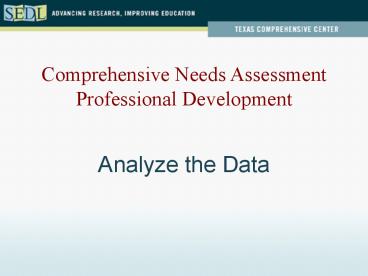Analyze the Data PowerPoint PPT Presentation
1 / 27
Title: Analyze the Data
1
Analyze the Data
Comprehensive Needs Assessment Professional
Development
2
Session Questions
- Why is data analysis a critical aspect of
school/district improvement? - How can data analysis focus the improvement work
in a school/district?
2
3
Data Analysis Can Help Us Answer Several
Questions
- Who are we?
- How do we do business?
- Where are we now?
- What are the gaps? What are the root underlying
causes of the gaps? - Where do we want to be? How can we get to where
we want to be? - (Bernhardt, 2006)
3
4
Delightful School Scenario
4
5
Questions About Delightful School
- 1. What data are currently being collected by
Delightful Intermediate School? - 2. What additional data might the school want to
collect? - 3. What strengths and weaknesses do you notice as
you read the scenario?
5
6
Predictions and Assumptions About What Exists
6
7
Possible Predictions
- Which is higher?
- reading or math performance
- district compared to school
- Has performance increased or decreased over 3
years? - Which groups of students are performing high?
Low? - Ethnicity
- Economically disadvantaged
- Special education
- LEP
- Other predictions?
7
8
Prediction Cards (Index cards)
Prediction 2
Prediction 1
Prediction 3
Prediction 5
Prediction 4
This activity is adapted from Data-Driven Dialog
A Facilitators Guide to Collaborative Inquiry, by
Bruce Wellman and Laura Lipton.
8
9
Predictions and Assumptions
- One person draws a card and reads a prediction.
- Everyone speculates on assumption(s) underlying
the prediction. - Next person draws a card and process continues.
- Spend no more than 3 minutes on each prediction.
9
10
Predictions and Assumptions
Predictions
Assumptions
10
11
Why Assumptions Are Important
- Accepted as fact
- No actual proof that they are true
- Serve as frames of reference for what we believe
to be true - Underlie our predictions about future events
- Usually unaware of our assumptions
11
12
AYP Indicators
12
13
2009 Adequate Yearly Progress Guide
http//ritter.tea.state.tx.us/ayp/2009/guide.pdf
2009 AYP Indicators
13
14
AYP Indicators
14
15
15
16
16
17
Delightful School Scenario Data Analysis
17
18
Rules of Engagement
- Make sure everyone participates.
- Respect each others ideas.
- Stay focused on the task.
- Avoid
- because statements,
- the blame game, and
- being defensive.
18
19
BECAUSE
19
20
Rules of Engagement
- Review one piece of data, with everyone at the
table simultaneously looking at the same data.
- While the data are important to understand, also
important is the collective nature of this
activityeveryone discussing the same data.
20
21
District and School AYP Data
- Three years of AYP reports for ABC District and
Delightful Intermediate School - Graphs of these reports disaggregated by
ethnicity, economically disadvantaged, special
education, and LEP
21
22
Adequate Yearly Progress Guide
http//ritter.tea.state.tx.us/ayp/2009/guide.pdf
22
23
Additional Data Sets
- Demographic data
- Attendance data
- Content area survey results
- Themes from focus groups and conversations with
leaders - If availableFindings from system capacity
rubric, additional relevant data
23
24
Examining the Data
- Use highlighters to indicate data that pop out
- Differences among subgroups of students
- Content areas in the greatest need for
improvement - Patterns or trends in demographics or other data
- Need for clarification or more information
24
25
Examining the Data
- Recorder will chart groups pop outs
- Remember No becauses
You have 30 minutes for this review. Spend
approximately 56 minutes on each data piece.
25
26
Reflection
- What are the benefits and challenges of analyzing
data collaboratively? - 5 minutes for table discussion, then report out
26
27
References
- Bernhardt, V. L. (2006). Using data to improve
student learning in school districts. Larchmont,
NY Eye on Education. - Texas Education Agency. (2009). 2009 adequate
yearly progress (AYP) guide for Texas public
school districts and campuses. Austin, TX
Division of Performance Reporting. - U.S. Department of Education. (2006). Designing
schoolwide programs Non-regulatory guidance.
Washington, DC Author. - Wellman, B., Lipton, L. (2004). Data-driven
dialog A facilitators guide to collaborative
inquiry. Arlington, MA MiraVia.
27

